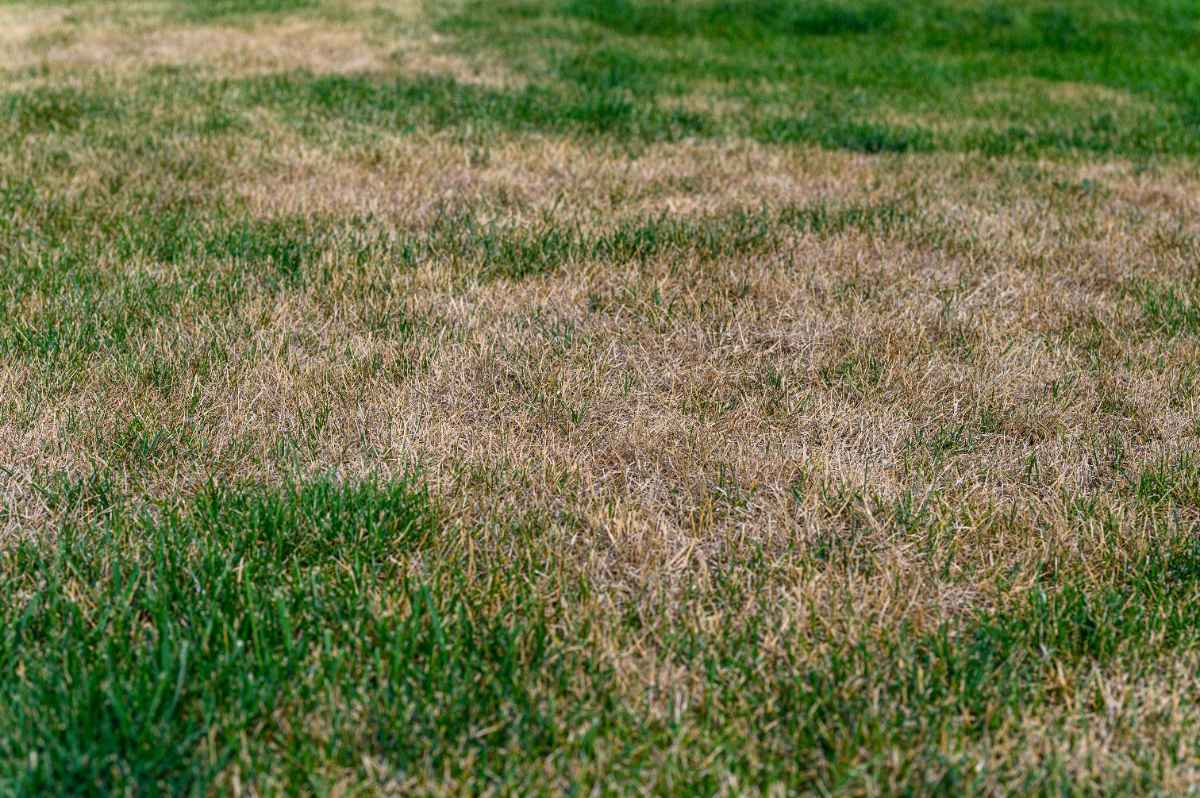
Many issues, like compacted soil and thatch problems, can cause grass to dry up even on a lush lawn. To fix dry patches on your lawn, you’ll need to adjust your watering, mowing, and aeration.
We’ve asked an expert to help explain the most common causes of dry grass and how you can bring these patches back to life. The exact method will depend on the root of the problem, which can also be drought stress, dog urine, fungal diseases, or even insect damage.
Fix Dry Patches Caused by Drought Stress
Insufficient watering in summer or inconsistent watering routines can cause spots on your lawn to get stressed and dry out. Grass blades may wilt, turn brown, and eventually die. But watering dead grass can bring it back if the crown is still alive.
According to Jason Lanier, turf management Extension specialist at the University of Massachusetts Amherst, “Recovery depends on the viability of the growing points of your plants (called the turfgrass crown) following a drought period.”
Do the following to fix dry grass on a drought-stressed lawn:
- Water your lawn deeply 2 to 3 times per week (around 0.5 inches each time) to encourage stronger roots that can access moisture underground. Shallow daily watering can weaken roots and worsen dry patches.
- Adjust sprinkler coverage by fixing blocked or misaligned sprinkler heads to ensure even lawn watering.
- Use soil wetting agents to help water absorb better into dry, hydrophobic soil.
Hire a LawnStarter pro to help fix your dry grass issue. And if your lawn can’t tolerate dry spells, you might want to replace it with a drought-tolerant grass like Bermudagrass or tall fescue.
Fix Dry Patches Caused by Compacted Soil
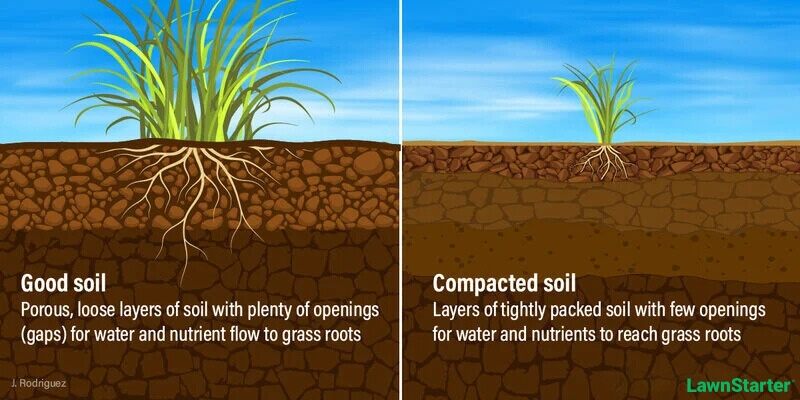
If your lawn has compacted soil, it can squeeze out the air and water the grass roots need to grow. Usually caused by clay-heavy soil or heavy foot traffic, soil compaction can lead to patchy, stressed grass despite regular watering.
To fix dry patches caused by soil compaction, you can aerate your lawn using either of these two methods:
- Core aerate: One of the best ways for relieving compaction is core aeration. With a core aerator, you’ll pull small plugs from the soil, allowing air, water, and nutrients to reach the roots again.
- Liquid aerate: A more gentle option would be to apply a liquid lawn aerator that uses soil-loosening compounds. While not as powerful as core aeration, it helps improve water absorption in minor cases.
Note: After aeration, prevent future soil compaction and help your grass recover faster by topdressing your lawn. Spread a thin layer of compost or sand over your lawn to encourage microbial activity and improve soil structure.
| Bundling aeration with overseeding costs around $362, but it can help you save time and effort. Last year, our pros performed around 245 aeration and overseeding services, which our customers gave an average rating of 4.1. Hire a landscaping pro in your area today. |
See Related:
Fix Dry Patches Caused by Thatch Problems
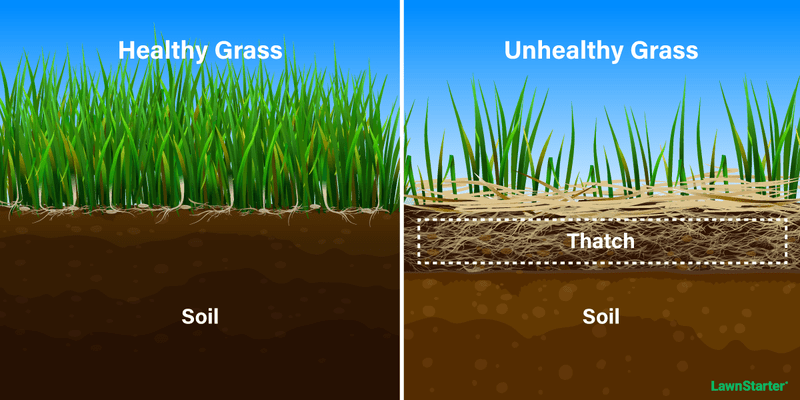
When thatch accumulates, it can block water, air, and nutrients, causing dead grass patches in lawns. Do the following to fix thatch problems:
- Dethatch your lawn: Use a thatch rake or machine to remove thick thatch layers over 1/2 inch.
- Adjust maintenance practices: Avoid over-fertilizing or overwatering your lawn, as they can encourage excessive thatch buildup.
- Mow properly: Cutting grass too short (lawn scalping) weakens turf and encourages thatch buildup. Remember to follow the one-third rule for mowing grass.
| Homeowners across the country love hiring LawnStarter mowing pros and give them an average rating of 4.5. In fact, our pros completed over 1.8 million mowing jobs last year, with each job costing around $51. |
Fix Dry Patches Caused by Dog Urine Spots
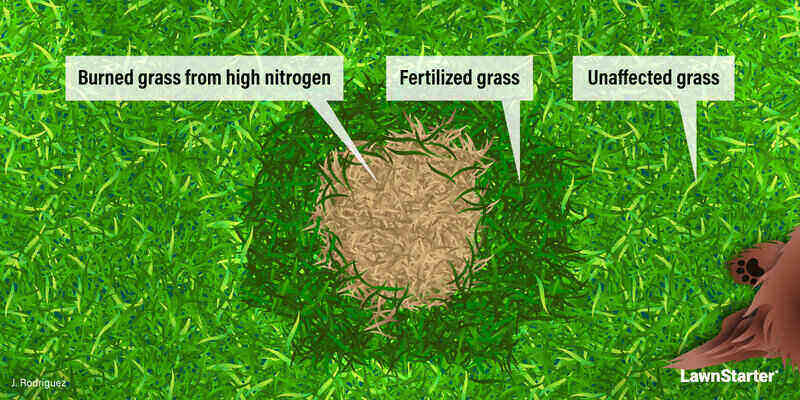
Since dog urine contains high levels of nitrogen and salts, it can burn grass and leave behind yellow or brown spots.
Lanier says, “While nitrogen is beneficial to grass in measured amounts, a large amount of concentrated nitrogen in readily-available form causes water to be drawn very rapidly from plant cells, which in turn causes rapid tissue death.”
You can’t stop a dog from regularly peeing on the lawn, so do these things to prevent or fix dog urine spots:
- Flush area: As soon as your dog pees, douse the spot with water to dilute the nitrogen and prevent burning.
- Spot treat: Use gypsum (or other dog urine neutralizers you can buy) to neutralize salts and restore soil balance.
- Repair lawn: Rake out dead grass, loosen the soil, and reseed the spot with the same grass type. Keep it moist until the new grass fills in.
Fix Dry Patches Caused by Disease Issues
Fungal lawn diseases, such as brown patch and dollar spot, can lead to dry grass. Prevention is best, but if your lawn is already suffering from a disease, you must treat it promptly.
- Improve air circulation: Trim overgrown shrubs and trees to allow more sunlight and airflow across your lawn. Better air movement helps dry moisture on grass blades, discouraging fungal growth.
- Apply fungicide: Use a lawn-safe fungicide labeled for your specific disease type. Follow directions carefully, and treat early to stop the spread and encourage recovery.
| LawnStarter pros also do lawn treatment services, which cost an average of $103 per service. They completed almost 40,000 lawn treatment jobs last year, and our customers gave them an average rating of 4.4. |
Fix Dry Patches Caused by Insect Problems
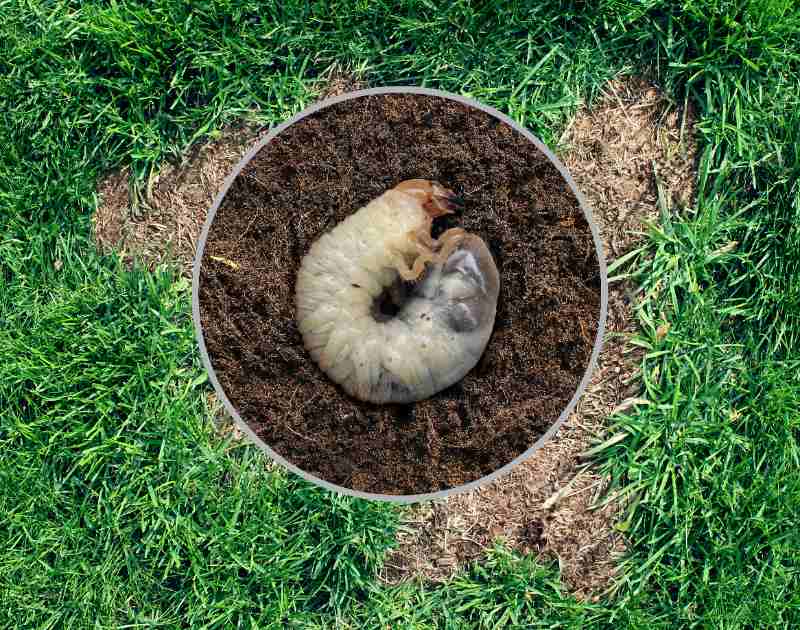
Certain lawn pests, such as grubs, chinch bugs, and armyworms, feed on grass roots or blades, causing the lawn to die in patches. They can turn green grass into dry grass almost overnight, especially in warm seasons when pests are most active.
- Confirm infestation: Dig into a patch and inspect for grubs or other insect pests before treating. Look for larvae near the soil line or insects crawling at the base of grass blades.
- Apply appropriate treatment: Use targeted insecticides or organic options like beneficial nematodes, depending on the pest.
Repairing and Reseeding Dry Patches
According to Lanier, “Lawn areas that don’t recover sufficiently when favorable conditions return can be targeted for more in-depth intervention.” And the best way to fix dead grass spots is by reseeding:
- Rake out dead grass
- Loosen the topsoil
- Apply matching grass seed
- Lightly cover with soil or compost
- Water consistently until new growth appears
FAQ About Fixing Dry Patches on Lawns
Watering, mowing, and aerating your lawn properly can help you prevent dry patches.
It depends on your needs and budget. You’ll get instant results if you choose to lay sod, but it’s more expensive. On the other hand, planting grass seeds is more time-consuming, but budget-friendly.
Depending on grass type and weather, new grass usually blends in within 2 to 6 weeks. Remember to take care of your new grass by watering it properly and avoiding foot traffic.
Proper Lawn Care Fixes Dry Patches and More
Taking care of your lawn doesn’t stop at fixing dry patches. Proper lawn maintenance will give your turf the care it needs to stay healthy year-round. If you’re not sure where to start, you can reach out to a LawnStarter lawn care pro who can diagnose the issue and help get your lawn looking green and lush again.
Sources:
- “Brown Patch & Large Patch Diseases of Lawns.” By Nancy Doubrava, former HGIC horticulture information specialist, and James H. Blake, Extension associate. Clemson University.
- “Brown Patch in Turfgrass.” University of Illinois Extension.
- Jason D. Lanier, turf management Extension specialist at the University of Massachusetts Amherst. Personal interview.
- “Managing Large Brown or ’Dead’ Patches of Grass in Spring.” By Aaron Steil, consumer horticulture Extension specialist, and Barbara Ambruzs, biological science technician. Iowa State University Extension and Outreach.
- “Now Is a Great Time To Fix Dead Spots in Lawns.” By Diana Alfuth, retired Extension horticulture educator. University of Wisconsin-Madison.
- “Tips to Avoid Lawn Problems.” By John F. Baniecki, Extension specialist. West Virginia University.
Main Image Credit: o_lypa / Adobe Stock